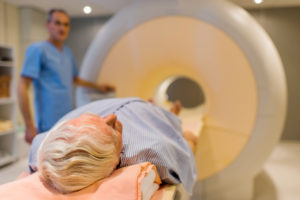Developing scan technology for more accurate data about Alzheimer’s disease
Although Alzheimer’s disease is the most common type of dementia in the UK, the exact cause is not yet fully understood. With the exception of Aducanumab – which was recently approved for use in the U.S – most current treatments offer partial improvement in symptoms rather than helping to slow down the progression of the disease.
To develop effective treatments for Alzheimer’s disease, we need technologies to measure what is happening in the human brain that are sensitive enough to the changes caused by Alzheimer’s. This is why researchers from the University of Cambridge are coming together with industry scientists to further develop scan technology.
What does the study involve?
The New Therapeutics in Alzheimer’s Disease study (NTAD) will measure the build-up of proteins in the brain using either a PET scan (Positron emission tomography) or a lumbar puncture test.
The PET scan uses a special dye that has radioactive tracers which are injected into the arm. This dye gets absorbed by the brain and the resulting images can then tell researchers exactly where the Alzheimer proteins (or amyloids) are in the brain and be able to pinpoint the earliest changes in the brain caused by Alzheimer’s disease.
Some participants may have a lumbar puncture test involving a thin needle being inserted into the lower back to collect a small amount of the clear spinal fluid which surrounds the brain and spinal cord. The fluid is then processed to measure the amyloids in the brain.
Following this, a new special brain scan called magnetoencephalography is used to measure tiny electromagnetic waves given off by active brain cells. Finally, participants will be asked to do an MRI (magnetic resonance imaging) test and memory tests for comparison.
The tests will be repeated after a fortnight in some patient participants, and after a year in all patient-participants.
Why take part?
Patients with Alzheimer’s disease, Mild Cognitive Impairment and control participants are invited to take part in the study to compare existing brain measures of Alzheimer’s disease to new and more sensitive ways to study the brain.
The project is being undertaken by James Rowe, Professor of Cognitive Neurology at the University of Cambridge, who says:
“To develop effective treatments for Alzheimer’s disease, we need accurate data about what is happening in the human brain. Procedures such as the PET scan and lumbar puncture provide great insights. Using these, we can measure not just the Alzheimer proteins but also a host of other chemistry and cells related to the illness which adds significant value to the data provided through participation.
This new scanning method measures the tiny electromagnetic waves given off by active brain cells. The MEG is quiet, bright, and performed sitting upright while watching a TV screen.
The findings will be used to understand the illness better, and to develop new clinical trials in the future.
Who can take part?
The study is looking for people in the East of England between the ages of 50 and 85, with a diagnosis of Alzheimer’s disease.
Participants must also be right-handed with normal or corrected vision (wearing glasses is ok) and no significant deafness.
This study is open until 30 June 2022 and is funded by Alzheimer’s Research UK and Dementia Platform.
To find out if you are eligible to join this study, as well as other dementia studies, sign in to your Join Dementia Research account or if you are not already registered, sign up today.

